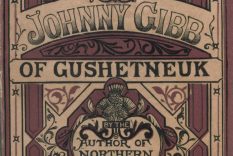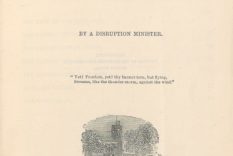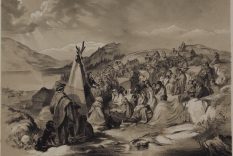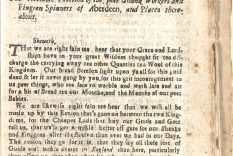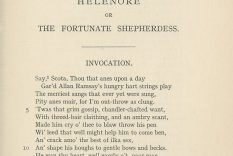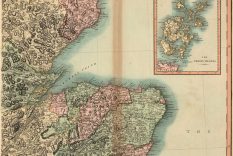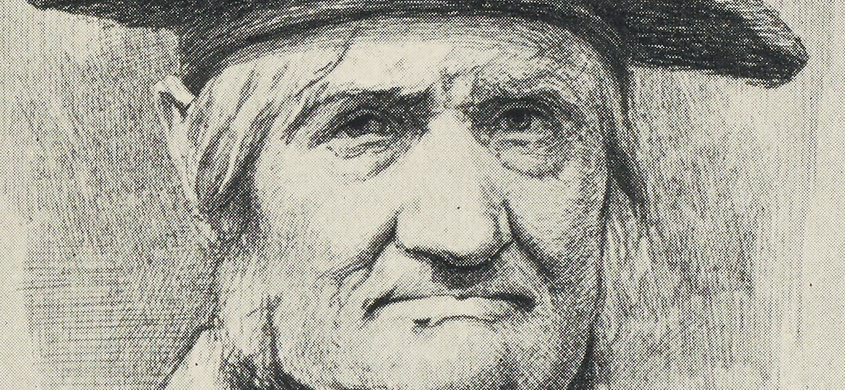
‘Johnny Gibb of Gushetneuk in the parish of Pyketillim with glimpses of the parish politics about AD 1843’, is a novel bi William Alexander. The novel opens wi an exchynge in Doric atween the protagonist an his hynd Tam Meerison as they redd up a cairt fir a recreational carrant tae the restorative Walls o MacDuff. Originally scrievit as a series o sketches fir the Aberdeen Free Press in 1869-1870, ‘Johnny Gibb of Gushetneuk’ wis imprentit as a collectit volume in 1871.
Aince a braid tairm fir the Scots leid as a hail, Doric became mair kent as the Scots dialect particular tae the north-east pairt o Scotland, an is thocht bi mony tae be the best preservit exaumple o the Scots tung.
Lear mair aboot Johnny Gibb an the Doric
William Alexander wis born at Rescivet in the Chapel o Garioch, the son o a smiddie, in 1802. Destined tae follae in the faimily tradition, the young Alexander tyned a leg in an accident which saw him chynge tack in life tae the sedentary tred o scriever. An essay on the weys o fairm servants wid win him local acclaim an gart him employment on the ‘North of Scotland Gazette’, syne he wid become editor o the ‘Aberdeen Free Press’.
Chimin wi the views o the eponymous worthie o his novel, Alexander wis a keen supporter o the reform o baith the pairliamentary franchise an the Kirk o Scotland, at that time insnorlt in the Intrusion controversy ower the richts o congregations tae elect parish meenisters. Follaein the Disruption o 1843 Alexander became an elder o the brekawey Free Kirk. Alexander alsae scrievit ‘Sketches of life among my ain folk’, imprentit in 1875. A kenspeckle figure amang philosophical circles in Aiberdeen, his memory wis gied muckle honour whan Mount Alexander in New Guinea wis handseled in his name bi an explorer wha had been an associate o Alexander.
The ‘Doric’ o Alexander’s novel foond earlier inspiration through the Scots vernacular revival o Allan Ramsay (1686-1758). In 1768 Alexander Ross’s ‘Helenore, or The Fortunate Shepherdess, a Poem in the Broad Scotch Dialect’, wis first imprentit. Scrievit some time afore 1740 it is thocht that ‘Helenore’ had originally been circulatit in manuscript form tae either complement or staund in direct rivalry tae Ramsay’s acclaimed ‘The gentle shepherd.’ Extendin tae fower thoosand verses an till that time thocht tae be the maist ambitious wark set oot in Scots, ‘Helenore’ drew no ainly on the Scots leid but on the distinctive speech o northeast Scotland, whaur the poem won great popularity. Burns thocht highly o ‘Helenore’ which wis said tae hae influenced him in his scrievin o ‘The Vision’.
The Rev John Skinner’s ‘The Monymusk Christmas Ba’ing’ wis prentit in 1739, a mettlesome description o a winter baw game scrievit in ‘Standard Habbie’, the verse form first set oot by Robert Sempill in his ‘The Life and Death of Habbie Simpson, the Piper of Kilbarchan’. Standard Habbie wid be yaised tae braw effect in the poetry o Ramsay, Robert Fergusson an Burns. Skinner’s poem dings alang wi swift movement an onomatopoeiac effect. Skinner wis alsae the scriever o several popular sangs includin ‘Tullochgorum’, which Burns enthused on as bein “the best Scotch song Scotland ever saw.”
In 1742 came Robert Forbes’s ‘Ajax his Speech to the Grecian Knabbs, from Ovid’s Metamorpheses, attempted in broad Buchans’. Forbes’s translation o Classical Literature intae northeast Scots echoed Gavin Douglas’s 1513 owersettin o Virgil’s ‘Aenid’ frae Latin intae Middle Scots.
A by-ordinar worthie cam tae the Doric revival o the 18th century in the figure o Alexander Geddes, a priest an linguist wha in 1779 had owerset the ‘Verses of Horace’ intae English. In 1792 Geddes presentit his ‘Three Scottish poems with a previous dissertation on the Scoto-Saxon dialect’, imprentit in ‘Archaeologica Scotica – Or Transactions of the Society of Antiquaries in Scotland.’
Geddes’s dissertation stairts wi somethin o an apologia in which he doonplays the contemporary wirth o Scots. He quos on its imperfection as a literary medium, its lack o consistent orthography an its practical yaise tae ony aspirin writer. Geddes includes Allan Ramsay in this plicht o the Scots leid an curiously omits ony mention o Burns. Thereftir, houanivir, he reenges on a historical quest tae shaw the divergence o the Scots an English leids frae thair common root, through military incursion, tred, political dynamics an the spreid o gospel religion. As Geddes gangs on he asserts the benefits in linguistic reenge an meanin o the Scots tung ower its southren coonterpairt, shawin the differences in vowel an consonant construction, a hantle o it still recognisable in variations atween Scots an staundart English in the present day. Geddes then proposes a new Scots orthography wi an alphabet comprising 42 symbols or symbal combinations, wi explanations gien fir each.
In three o his poems, Geddes presents twa o these, ‘The First Eklos of Virgil’ an ‘The First Idillion of Theokritus’, scrievit in his unique Scots or Skotis orthography. Geddes finalises his dissertation tae the Society of Antiquaries wi a proposal that a new projeck be set oot fir a staundart Scoto-Saxon lexicon.
By the time Geddes wis settin oot his proposal, John Jamieson had aready begun hairstin wirds an expressions fir his ‘Etymological dictionary of the Scottish language’, imprentit in twa volumes in 1808. Jamieson’s dictionary wid become the foondation fir subsequent etymological studies o the Scots leid.
Johnny Gibb of Gushetneuk in the parish of Pyketillim with glimpses of the parish politics about AD 1843’, is a novel by William Alexander. The novel opens with an exchange in Doric between the protagonist and his farm servant Tam Meerison as they prepare a cart for a recreational jaunt to the restorative Wells of MacDuff. Originally written as a series of sketches for the Aberdeen Free Press in 1869-1870, ‘Johnny Gibb of Gushetneuk’ was published as a collected volume in 1871.
Once a broad term for the Scots language as a whole, Doric became more often known as the Scots dialect particular to the north-east part of Scotland, an is thought by many to be the best preserved example of the Scots tongue.
Learn more about Johnny Gibb an the Doric
William Alexander was born at Rescivet in the Chapel of Garioch, the son of a blacksmith, in 1802. Destined to follow in the family tradition, the young Alexander lost a leg in an accident which saw him change course in life to the sedentary occupation of a writer. An essay on the ways of farm servants won him local acclaim and secured him employment on the ‘North of Scotland Gazette’. Thereafter he would join and eventually become editor of the ‘Aberdeen Free Press’.
In agreement with the views of the eponymous character of his novel, Alexander was a keen supporter of the reform of both the parliamentary franchise and the Church of Scotland, at that time embroiled in the Intrusion controversy over the rights of congregations to elect their parish ministers. Following the Disruption of 1843 Alexander became an elder of the breakaway Free Church. Alexander also wrote ‘Sketches of life among my ain folk’, published in 1875. A recognisable figure among philosophical circles in Aberdeen, his name was honoured in the naming of Mount Alexander in New Guinea by an explorer and associate.
The ‘Doric’ of Alexander’s novel found earlier inspiration through the Scots vernacular revival of Allan Ramsay. In 1768 Alexander Ross’s ‘Helenore, or The Fortunate Shepherdess, a Poem in the Broad Scotch Dialect’, was first published. Written some time before 1740 it is believed that ‘Helenore’ had originally been circulated in manuscript form to either complement or stand in direct rivalry to Ramsay’s acclaimed ‘Gentle Shepherd.’ Extending to four thousand verses and until that time believed to be the most ambitious work to be written in Scots, ‘Helenore’ drew not only on the Scots language but on the distinctive speech of northeast Scotland, where the poem attained great popularity. ‘Helenore’ was admired by Burns and is said to have influenced him in his writing of ‘The Vision’.
The Rev John Skinner’s ‘The Monymusk Christmas Ba’ing’ was published in 1739, a spirited description of a winter ball game written in ‘Standard Habbie’, the verse form first set out by Robert Sempill in his ‘The Life and Death of Habbie Simpson, the Piper of Kilbarchan’. Standard Habbie would be used to strong effect in the poetry of Ramsay, Robert Fergusson and Burns. Skinner’s poem hums along with swift movement and onomatopoeiac effect. Skinner was also the author of several popular songs including ‘Tullochgorum’, which Burns enthused on as being ‘the best Scotch song Scotland ever saw.’
In 1742 came Robert Forbes’s ‘Ajax his Speech to the Grecian Knabbs, from Ovid’s Metamorpheses, attempted in broad Buchans’. Forbes’s translation of Classical Literature into northeast Scots echoed Gavin Douglas’s 1513 translation of Virgil’s ‘Aenid’ from Latin into Middle Scots.
An extraordinary character came to the Doric revival of the 18th century in the figure of Alexander Geddes, a priest and linguist who in 1779 had translated the ‘Verses of Horace’ into English. In 1792 Geddes presented his ‘Three Scottish poems with a previous dissertation on the Scoto-Saxon dialect’, published in ‘Archaeologica Scotica – Or Transactions of the Society of Antiquaries in Scotland.’
Geddes’s dissertation begins with something of an apologia where he downplays the contemporary worth of Scots. He comments on its imperfections as a literary medium, its lack of a consistent orthography and questions its practical use to any aspiring writer. Geddes includes Allan Ramsay in this plight of the Scots language and curiously omits any mention of Burns. Thereafter, however, he goes forth on a historical quest to show the divergence of the Scots and English tongues from their common root, through military incursion, trade, political dynamics and the spread of gospel religion. As Geddes progresses he asserts the benefits in linguistic range and meaning of the Scots tongue over its southern counterpart, demonstrating the differences in vowel an consonant construction, some still recognisable in variations between Scots and standard English in the present day. Geddes then proposes a new Scots orthography with an alphabet comprising 42 symbols or symbol combinations, with explanations given for each.
In three of his poems, Geddes presents two o these, ‘The First Eklos of Virgil’ an ‘The First Idillion of Theokritus’ written in his unique Scots or Skotis orthography. Geddes finalises his dissertation to the Society of Antiquaries with a proposal that a new project be undertaken for the setting out of a Scoto-Saxon lexicon.
By the time Geddes was setting out his proposal, John Jamieson had already begun gathering words and expressions for his ‘Etymological dictionary of the Scottish language’, published in two volumes in 1808. Jamieson’s dictionary would become the foundation for subsequent etymological studies of the Scots language.
- Author:
- Publication Date:
- 1869
- Imprentit:
Johnny Gibb of Gushetneuk
‘HEELY, heely, Tam, ye glaiket stirk ye hinna on the hin shelvin o’ the cairt. Fat hae ye been haiverin at, min ? That cauff saick’ll be tint owre the back door afore we win a mile fae hame. See ‘t yer belly-ban’ be ticht aneuch noo. Woo, lassie ! Man, ye been makin’ a hantle mair adee aboot blaikin that graith o’ yours, an kaimin the mear’s tail, nor balancin’ yer cairt, an’ gettin’ the things packit in till ‘t.’
Frae ‘Johnny Gibb of Gushetneuk’


